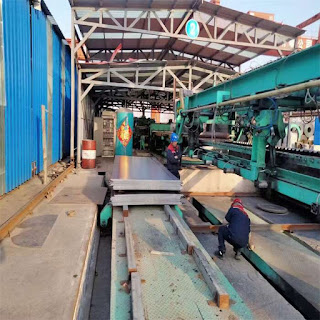Manganese is a good deoxidizer and desulfurizer. Steel generally contains a certain amount of manganese, which can eliminate or weaken the hot brittleness of steel caused by sulfur, thereby improving the hot working performance of steel.
Manganese and iron form solid solution to improve the hardness and strength of ferrite and austenite in steel. It is also a carbide forming element that enters the cementite to replace some iron atoms. Manganese in steel due to lower critical transition temperature. It plays the role of refining pearlite. It also plays an indirect role in improving the strength of pearlite steel; Manganese is second only to nickel in its ability to stabilize austenitic structures and also strongly increases the hardenability of steel. A variety of alloy steels have been made with manganese of less than 2% combined with other elements.
In high carbon and high manganese wear-resistant steel. Manganese content can reach 10%-14%, good toughness after solid solution treatment, when the impact and deformation, the surface layer will be strengthened due to deformation, with high wear resistance.
Manganese and sulfur form MnS with higher melting points. Prevents thermal brittleness caused by FeS. Manganese has the tendency to increase grain coarsening and temper brittleness sensitivity of steel. If the cooling after smelting casting and forging rolling is not proper, it is easy to produce white spots in steel.
(1) The effect of microstructure and heat treatment of steel
A, manganese is a good deoxidizer and desulfurizer, industrial steel generally contains a certain amount of manganese.
B, manganese soluble in ferrite and austenite. The austenite region is enlarged, so that the critical temperature of A4 is increased, A3 is decreased, and the (α+γ) region is moved down. When the manganese content exceeds 12%, the upper critical point drops below room temperature, allowing the steel to form a single austenitic structure at room temperature. At the same time, the eutectoid temperature is reduced, and the carbon content in the eutectoid is reduced.
C, manganese strongly reduces the Ar1 and martensitic transition temperature of steel (its role is second only to carbon) and the speed of phase change in steel, improves the hardenability of steel, and increases the residual austenite content.
D, the tempered structure of the steel is uniform and refined, avoiding the aggregation of carbides in the carburizing layer, but increasing the overheating sensitivity and tempering brittleness tendency of the steel.
E, manganese is a weak carbide forming element.
(2) Effect on mechanical properties of steel
A. The effect of manganese on strengthening ferrite or austenite is less than that of carbon, phosphorus and silicon, which has no effect on ductility while increasing strength.
B, because the pearlite is refined, the strength of low carbon and medium carbon pearlite steel is significantly improved, and the ductility is reduced.
C, by improving the hardenability and improve the mechanical properties of tempered sortensitic steel.
D, under the premise of strict control of heat treatment process, avoid overheating grain growth and temper brittleness, manganese will not reduce the toughness of steel.
(3) The effect on the physical, chemical and technological properties of steel
A. With the increase of manganese content, the thermal conductivity of steel decreases sharply, and the linear expansion coefficient increases, so that the internal stress is formed during rapid heating or cooling, and the cracking tendency of the workpiece increases.
B, the electrical conductivity of the steel decreases sharply, the resistivity increases correspondingly, and the resistance temperature coefficient decreases.
C, the coercive force increases, saturation magnetic induction, residual magnetic induction and permeability are reduced, so manganese is beneficial to permanent magnet alloy and harmful to soft magnetic alloy.
D, when the manganese content is high, the oxidation resistance of the steel decreases.
E, the sulfur in the steel to form a higher melting point of MnS, to avoid the FeS film on the grain boundary, eliminate the hot brittleness of the steel, improve the hot processing performance.
F, high manganese austenitic steel deformation resistance is larger, and the ingot columnar crystallization is obvious, more easy to crack during forging and rolling.
G. Due to improved hardenability and reduced martensitic transition temperature, it has an adverse effect on welding performance. Carbon content should be reduced to an appropriate extent.
(4) Application in steel
A. There is often an appropriate amount of manganese and phosphorus in the free-cutting steel, and MnS inclusions make the chips easy to break.
B, the use of manganese in ordinary low-alloy steel to strengthen ferrite and pearlite, improve the strength of steel, manganese content is generally 1%-2%.
Many series of C, carburized and tempered alloy structural steels contain no more than 2% manganese.
D, the use of manganese in spring steel, bearing steel and tool steel to strongly improve the role of hardenability, can use oil quenching and air cooling quenching process to reduce cracking, distortion and deformation.
E, wear-resistant steel, non-magnetic steel, stainless steel, heat-resistant steel, including high carbon and high manganese wear-resistant cast steel (C: 1.0%-1.4%, Mn: 10%-14%), medium carbon high manganese non-magnetic steel (C: 0.3%-0.6%, Mn: 18%-19%), low carbon high manganese stainless steel (Cr, no Ni or less Ni), High manganese heat resistant steel (heat resistant non-peeling steel with Mn instead of Ni, or containing Al, Mo, V, etc.).
Email: sale@galaxy-steel.com
Wechat: LXF13931739696. Whatsapp: 008613931739696
Website: www.friend-steelpipes.com www.cz-steelpipe.com
CANGZHOU GALAXY STEEL PIPE CO., LTD
























